Aislinn Marshall's Blog
October 16, 2013
Lemp Mansion Investigation
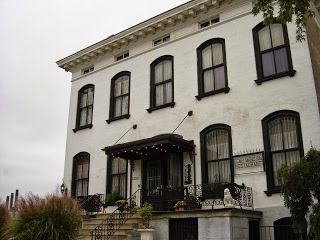
Exterior of the Lemp Mansion
The Lemp Mansion
Well it’s finally here! My follow up blog on the Lemp Mansion! Sorry it took me so long to get this back to all of you but going through video, pictures and voice recordings took much longer than I originally estimated.
The Lemp Experience
My team, Jenn, Charles (my brother), and myself, arrived at the mansion just before 9:00pm where our night was to begin with the mansion sponsored “Lemp Experience,” which was a tour and ghost hunt with a local paranormal group. During the tour both Jenn and I had personal experiences. At one point we were heading into the Lavender Suite on the second floor, when Jenn felt tugging at her pants leg. And in the front right dinning room on the first floor I experienced a tingling sensation all over my head. At that point we knew it was going to be a good night!
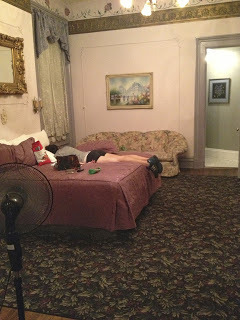
The Lavender Suite(Jenn Taking a little Nap)
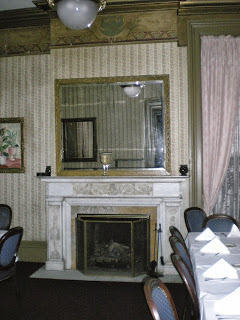
Front Right Dinning room The tour lasted an hour and then it took another hour for the mansion to empty of other guests. Around 11:30pm we found ourselves alone. Unlike other bed and breakfasts’, at the Lemp Mansion there is no overnight staff, so you’re on your own till morning!
EVP Sessions
Once all the other guests had left, we began getting our equipment organized and going over the plan for the night. We set up video cameras to record in several areas of the mansion and began taking photographs of every room in the house. Once we were all set up we waited for a short while just to let the house settle down and then we began our EVP sessions. We moved from room to room asking questions and hoping for a response. Some rooms felt more active than others. The front left dinning room was one of the more active spots as all three of us experienced something. At one point during the session I felt as though someone was draping a blanket over my back. I asked if it was one of the Lemp’s and it happened again! Charles heard a whisper, and Jenn felt waves of static energy. We thought for sure when we played back our recorders we would have captured some evidence. But there was nothing.One area of the house believed to be a “hot spot” is the bedroom where Charles Lemp took his life on the second floor. Just before 3:00am we set up for an EVP session. As we had done in all the other rooms prior, we also set up a flashlight with a twist back that had been slightly loosened. We began asking questions and continued to do so for around five minutes before Charles mentioned the flashlight and asked that if Charles Lemp was with us, could he turn it on. And it lit up! We were astonished! We’d placed the flashlight in so many rooms prior with no interaction. And then just when we asked for it…It came on!
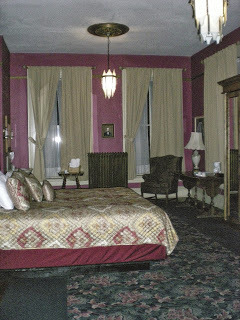
Charles Lemp Bedroom
The spirit continued for around fifteen minutes to turn the light on and off for us. But even though we’d seen it with our own eyes we were skeptical. So when we entered the next room, we didn’t loosen the back of the flashlight. We made it so that if a ghost were to turn it on it was just as difficult for them as for us. It was around 3:30am when we entered the William Lemp suite. There was a thunderstorm raging outside and the mood seemed movie perfect for our next session. We began asking questions just as before and after a while asked if the spirit was one of the Lemps, could they turn on the flashlight. Nothing. I then asked if it was a border who’d lived in the house after the Lemps had left. And on it popped! We were even more amazed this time as we knew there was no chance that the light had accidentally come on. We asked if they could turn the light off for us, and they did. No hesitation. It was on and then off. We could also hear the sound of the flashlight moving slightly on the bench were we had set it. We asked it to turn it on and off for us a few more times and the spirit did so each time. It wasn’t till we began asking question about the Lemp nursery, that is thought to be the most haunted spot in the house, that we lost communication. But the experience was amazing!
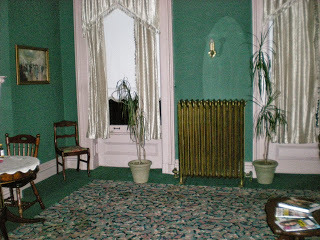
William Lemp Suite
By around 5:00am in the morning we had investigated every room in the house and decided to gather our equipment and go. It was bittersweet as we’d had some amazing experiences and we were all eager to have more. But there was still the evidence to go over.
What we Caught
There was what seemed like countless hours of recordings to go over but in the end we caught two EVP’s!!! The first was caught in the Lemp main dining room on the first floor. Prior to beginning our session we’d been talking a lot about the dog that Charles Lemp had killed along with himself. My brother had experienced the dog brushing up against his leg on an earlier visit to the Lemp and since then we’d all become fascinated by him. But eventually we began the session. I asked, “Is there anyone here with us?” And just after, on the recording, you hear a dog bark! Dog Bark: www.http://soundcloud.com/aislinnam
Our next EVP was caught in the room we were staying in, the Lavender Suite. We were in the middle of a session when we heard a loud click. Charles asks, “Was that you that just made that noise?” And then you hear footsteps leading away! What’s really interesting is that the footsteps sound as though they are on hardwood floors but the Lemp is fully carpeted these days.
Footsteps: www.http://soundcloud.com/aislinnam
NOTE: Both of these EVP’s are best listened to with headphones. And the “Footstep” Evp plays through once at regular volume and then I’ve looped it to play again with the volume turned up. Also there is a major highway that passes by right next to the Lemp Mansion so a lot of the background noise you hear is road noise.
A Sampling of Pictures from the Investigation
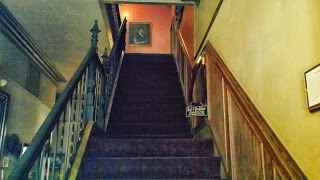
Main Staircase
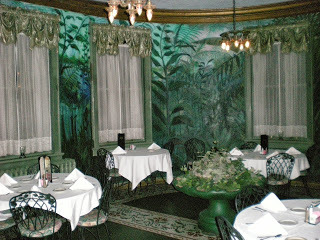
Solarium
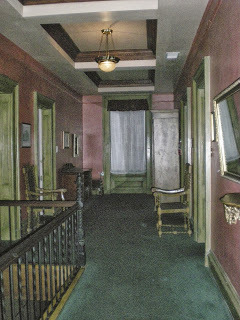
Upper Hallway facing the William Lemp Suite
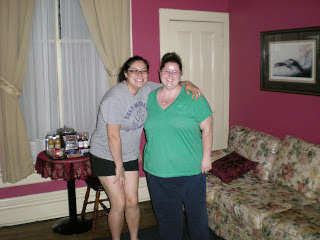
We were a bit Slap-Happy by 5am in the Charles Lemp Room
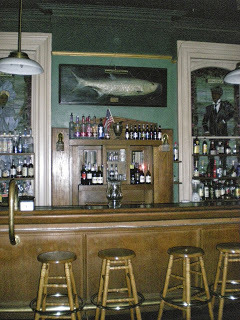
Bar on the main Floor
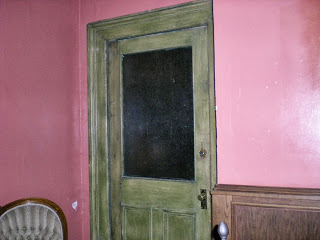
Door to the Nursery
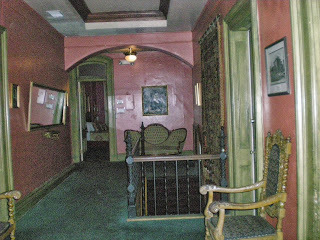
Hallway Facing Charles Lemp Room
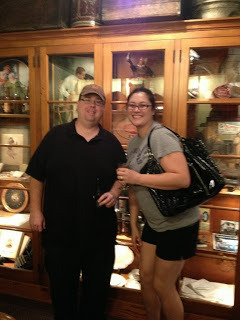
Charles and Jenn in the Lemp Museum and Gift Shop
Comments Or Questions?
If you have any comments or questions please contact me at aislinnmarshallwriter@gmail.comor leave a comment here. You can also find me on Twitter and Facebook under AislinnAM
Published on October 16, 2013 18:17
September 19, 2013
The Lemp Family of St. Louis: Lager, Suicide and Ghosts
A Very Brief Overview
Tonight I’ll be staying at the Lemp Mansion in St. Louis and I thought a brief overview of the family and why the house is so haunted was in order. This is just a tiny view of the rise of a brewing empire and its subsequent fall.
The Family and Business
Adam Lemp, a German immigrant to St. Louis, was the first in the city and among the first in the US to brew lager. As thus, he quickly built the foundation of a empire for himself and his family during the mid 19th century. Upon Adam’s death in 1862, his son, William J. Lemp took over the business and propelled the brewery into the 20thcentury by installing the first refrigeration unit in an American brewery. He also became the first in St. Louis to install a bottling plant on the same grounds where the beer was brewed. But he didn’t stop there, he also purchased his own railway company in order to sell his beer across the country and internationally. By the 1900’s the Lemp’s were among the wealthiest families in St. Louis and there was no sign of a decline anytime soon. But fate struck in 1901 when Frederick Lemp, William J. Lemp’s favorite son died of heart failure knocking over the first domino in what would be a cascading collapse of the family. Frederick was reported to be William’s favorite son and his death hit him hard. But no one realized just how hard until a gun shot rang out from his bedroom on the morning of February 13th1904. William J. Lemp was dead. He had taken his own life and become the first of four suicides the Lemp family would suffer before the end. While William Lemp Jr. did his best to hold on to the family business after his father’s death, prohibition took all control out of his hands. In 1920 it became illegal to sell alcohol in the United States and the Lemp business was suddenly without a product to sell. Even though the Lemp family wealth was more than enough to see them through the hard times ahead, prohibition marked the end of one of the greatest brewing dynasties in the United States. It was at this time that the Lemp family lost it’s second member to suicide. Though her motives are not completely clear, in March of 1920 Elsa, the youngest daughter of William Sr. shot and killed herself in the same manner as her father. She had recently gone through marriage difficulties and suffered from a bout of depression due to health problems. But no note was ever found. Then, just two years later in December of 1922, William Lemp Jr. also shot and killed himself. It was known that William had gone through a rather difficult and public divorce in which he lost custody of his son and, due to prohibition, was now losing his company. All this sent him into a deep depression which sadly resulted in the taking of his own life. After prohibition, an attempt at reviving the Lemp name in beer was made by William Lemp III, but failed ending the dynasty once and for all. Members of the family continued to live off of the great wealth amassed by their predecessors but also engaged in their own business ventures. But the stream of suicides had not yet run their course. In 1949 Charles Lemp, a son of William Sr. was still living in the Lemp mansion. Not much is known about Charles as he was a bit of a recluse. He never married and had very little to do with social life. But it was known that he was suffering from illness and acute arthritis which had made him grow bitter and tired. In May of 1949, Charles decided he’d had enough and he too shot and killed himself along with his dog. After Charles’s death his fortune was split among the remnants of the family but the mansion was never occupied by a member of the Lemp family again. With so much death and tragedy it’s no wonder the Lemp Mansion is reported to be haunted by spirits of the family. The current owners of the mansion, employees, guests and even professional investigators report paranormal activity at Lemp. Some of the claims are of disembodied voices, feelings of being watched, lights turning on and off on their own, strange smells and feelings of dread. These experiences combined with the mansion’s sad past have put the Lemp Mansion on the map as one of the most haunted spots in the United States.
Where to hear about my night at Lemp
As previously mentioned I’ll be staying the night at the Lemp Mansion Thursday, September 19th and I’ll be live tweeting about my experience throughout the night. You can find my tweets at @AislinnAM. Also, after the event I’ll be posting information on my visit here at the blog along with pictures and any other evidence we might find. So be sure to check back!
Questions or Comments?
As always, if you have any questions or comments for me, please feel free to contact me either through email at aislinnmarshallwriter@gmail.com or leave a comment here!
Published on September 19, 2013 10:19
September 15, 2013
Lemp Mansion Ghost Hunt
Lemp Ghost Hunt
If you follow me on either Twitter or Facebook you probably already know that I’m participating in a Ghost Hunt this Thursday, September 19, 2013 at the Lemp Mansion in St. Louis Missouri. The “hunt” is sponsored by the mansion and starts at 9:30pm Central Time. Afterword myself and a good friend, who is also a sensitive, will stay the night in the mansion to carry on our own investigation. And we will be bringing it all to you via live Tweet! For those who don’t know, the Lemp Mansion is considered one of the most haunted houses in the United States and ranks pretty high worldwide. Not impressed? Well neither was I prior to the first time I visited this alleged spot of ghostly activity back in 2002. That night myself and my small party had the house to ourselves. In those days there were only three rooms available and we decided to book them all for the night. But not for any sort of ghost investigation because none of us actually believed in ghosts! But all that changed after one night at Lemp. We thought it would be fun to stay in a “real haunted house” at Halloween time but being nonbelievers we had no expectations of anything actually happening. In fact the first half of the night we dismissed every strange happening. But in the end we couldn’t ignore that there were noises coming from everywhere and nowhere. Lights that turned on by themselves. Uneasy feelings and moments of dread. We went in with a perfect knowledge that there was no such thing as ghosts, and came out complete and absolute believers. That was over a decade ago and when we left, we swore that except for Sunday night dinner none of us would ever stay the night at Lemp again. And we made good on that declaration till now. In fact, for years after our experience I personally didn’t go to the upper levels of the house when we came for dinner. It was only after they finished the renovations of the third floor that I finally got the nerve to go navigate that creaky back staircase. But several months ago after releasing my first book, The Crossing, I began thinking about the Lemp Mansion and my experience there. Since that night so long ago, I’ve visited many haunted spots across the world. I’ve braved them without thought and with actual excitement. But Lemp still stood as a symbol of foreboding for me even though it was my experience there that truly sparked my interest in the supernatural. So with one ghost story behind be and my next novel, All Souls’ Night, on the way. I thought it was time to revisit the spot where my life took a drastic turn that lead me down a new road as a writer of supernatural mysteries and ghost stories. I’m not going to lie, I’m a little nervous. But I’m also excited not only to see what road the Lemp might send me down this time but also to share my experience with all of you! Myself and my good friend, Jenn, will begin tweeting around 9:00pm Central Time here in the US. You can find our tweets at @AislinnAM and @frenchy0309. And be sure to check back here before and after the 19th as I’ll be posting information about the history of the Lemp mansion and why it’s so haunted. Also, after the 19th I’ll let you know what our night in the Lemp yielded, with pictures and hopefully EVP’s and video!
Questions or Comments?
As always, if you have any questions or comments for me or about any of my blogs please feel free to contact me at aislinnmarshallwriter@gmail.comor leave a comment here!
Published on September 15, 2013 20:20
July 22, 2013
Tarot Cards: Ancient Origins and Modern Uses
What Are They
Tarot cards consist of a total of 78 cards. These cards are separated into major and minor “arcana,” a word that in Latin means, secret. The minor arcana is very much like a regular deck of playing cards with suits of hearts, diamonds, clubs and spades (although they had different names in the middle ages – swords, batons, cups and coins). While the major arcana is made up solely of picture cards. These picture cards are the ones most people associate with tarot and fortune telling. Here we find such cards as the magician, death, the fool and even the devil.
Origins and Uses
The exact origin of the first tarot cards is unknown but there is a strong argument that they originated in Egypt and that their name is a rough derivative of the Egyptian god Thoth. In Egypt, Thoth was the god who kept the universe in order and was highly skilled in the art of magic. So it’s not a far stretch to see where cards that are meant to magically reveal ones future in the universe could be ascribed to him. However, as ancient as these supposed origins of tarot are, what we know as tarot cards today didn’t show up until the fifteenth century in Italy. These cards are said to have been brought to Italy, and eventually the rest of Europe, by gypsies. Originally, gypsies used these cards to play several different card games that could be bet and gambled on. But over time they found their niche as fortune telling cards. In a way, tarot became a form of therapy or self help. If a person was concerned over the future, or plagued with a tough decision, or maybe even unhappy and didn’t know what to do to make it better, they would seek out the help of a gypsy fortune teller. The fortune teller would have that person shuffle the cards while focusing on their problem. Then the fortune teller would “read” the cards. By read, I mean that they would turn over cards and tell the fortune seeker what they represented. Thus putting the translation of the cards into the hands of the person with the problem rather than assigning any meaning to the “whole” of the reading themselves.
Modern Day
Now days, the use of tarot is very much the same. Among mystic groups it’s seen as an invaluable tool and people still seek out the aid of the cards for making decisions in both their personal and professional lives. But it’s no longer necessary to have a “reader” of the cards. It is now thought that a person is completely capable of using the cards themselves to find answers to their questions. Some even use the cards daily as a way to place focus or meaning on the day. For example: if one turns up the “Sun” card, they might use it as a reminder to use their creative side when facing the day’s challenges. That said, most fairs and carnivals still have an old gypsy fortune telling booth that’s steeped in mystery and dripping with the promise to each and every passerby a clear view into their future for the mere price of a dollar.
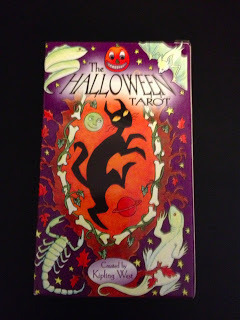
A pack of Halloween themed tarot cards
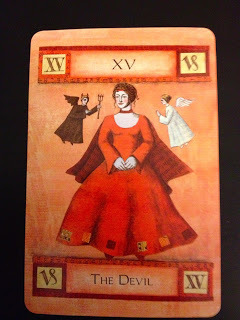
The Devil: Represents struggle, manipulation, decisions and potential.
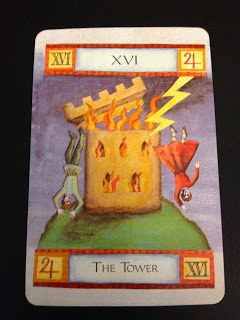
The Tower: Represents Change, speed, and insight.
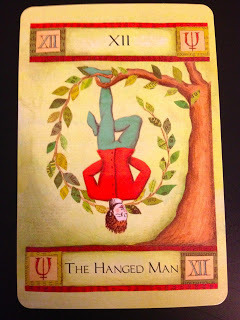
The Hanged Man: Represents viewpoints, hope, the unconscious and waiting.
Comments and Questions
If you have any comments, questions or anything to add, be sure to leave a comment here or contact me at Aislinnmarshallwriter@gmail.com or through my website AislinnMarshall.com
Published on July 22, 2013 08:55
June 21, 2013
Midsummer and Litha
Midsummer
While the summer solstice (usually falling on or around June 21st) is the beginning of summer in our modern world, in ancient times it was the half way point between the times of planting and harvest. The Celts called the solstice Litha and it was celebrated as a fire festival all over Ireland and parts of Europe. On Litha, large bonfires were lit to keep the evil sprits and meddling fairies that ran free on that night at bay, and the people reveled in one last day before the darkness of the approaching winter started creeping in. It was also a time for gathering in magical or medicinal plants. It was thought that plants with yellow flowers, like the sun, contained extra special healing properties when picked on Litha night.
Modern Celebrations
Today, Litha is called Midsummer in most parts of the world and is celebrated on almost every continent. It remains especially important in Ireland and Scandinavia. Huge bonfires are still lit in most of the celebrations and people gather through the night for music and festivities. I’m personally not much for a big crowd and I don’t know of any community celebrations in my area of the US, so I usually throw together my own party. Last year I had a simple backyard barbeque, and decorated the tables with candles in place of a bonfire and set out fresh yellow flowers to represent the healing herbs that would have been gathered on that night. For the kids, I got some inexpensive bug holders and nets ( I got mine from the dollar store), so they could run around catching lightning bugs or “fairies” as the evening fell. For desert, I made my version of fairy cakes (see recipe below). I’ve been told that the real thing is nothing more than a small cupcake with a dab of frosting on the top but being summer and rather hot and sticky here in St. Louis, I opted for a less sugary muffin with a small amount of powdered sugar on top. Whatever you decide to do for Midsummer, just keep in mind that it’s a night when fairies roam the land and plants transform from weed to healing potion, so make it magical!
Fairy Cake Recipe
1 egg
1/2 cup milk
1/4 cup vegetable oil
1 1/2 cups all-purpose flour, sifted
1/2 cup sugar
2 teaspoons baking powder
1/2 teaspoon saltPowdered sugar for dusting Chopped nuts or dried fruit if desired
Directions:
1) Heat oven to 400. Line 12 muffin cups with paper liners.
2) Beat egg; stir in milk and oil. Mix remaining ingredients just until flour is moistened. It will be lumpy at this point. Also, if you’re adding fruit or nuts, now is the time.
3) Fill muffin cups 1/2 to 2/3 full. Bake 20-25 minutes or until golden. Immediately remove from pan and place on cooling rack or on their sides to cool.
4) Once cool, dust with powdered sugar and enjoy!
Contact Me
As always, I’d love to hear from you! If you have any questions or comments please leave them here or contact me through my website, aislinnmarshall.com or email me at aislinnmarshallwriter@gmail.com.
Published on June 21, 2013 09:07
May 29, 2013
Olde English Witch Balls
Then
Witch balls originated in 18th Century England. The seventeen-hundreds were a turbulent time for witchcraft in England as it was a century that saw both the execution of witches and the abolishment of the idea that a person could even be guilty of witchcraft through the Witchcraft act of 1735. For the average person it must have been a confusing time. Are witches real and to be feared? Or simply illusionary? Fortunately, witch balls presented a passive-aggressive solution to the problem. They were something that could be used to protect ones self from the danger of a witch’s curse or spell, without accusing or persecuting any members of the community. And what’s more, they were, and are, very beautiful. Most witch balls are blown glass with strings of glass that look like webbing running through the inside portion. It was believed that these balls would attract any evil curse or spell trying to enter ones home. Thus, it became customary to hang the balls from the homes window’s. Then, as the witch’s dreadful curse approached to do it’s harm, it would instead find itself trapped in the inner webbing of the witch ball, leaving the home safe from evil. And it was believed that if the witch ball began to glow, a curse was trapped inside. Some variations of witch balls were silvered to create a mirror like image that would reflect the evil curse away from the home rather than trapping it inside the webs. It’s this form of witch ball that our garden gazing balls developed from. Witch balls are also associated with seafaring. In time, the purpose of witch balls expanded to include the attraction and inevitable capturing of evil spirits along with witches’ curses. During the early days of seafaring, when fishermen cast their nets into the sea, they would use glass balls, know as float balls, to weigh down the nets. But on the eastern coast of the United States, many fishermen would change out the float balls for witch balls in hopes of capturing the evil spirits that rode along the waves.
Now
With the popularity of witch balls back in England, it’s no surprise that they eventually made their way across the Atlantic to the United States. Here, witch balls saw their heyday in the 19th century but soon died out in popularity what with the turbulence of the war and other concerns that were far more real than a witch’s curse. However, they remain a very popular souvenir and novelty item. There’s not a shop in Salem Massachusetts where you can’t find one for sale. And I myself have purchased a dozen or so on my trips there. They now make for a beautiful display in my front window!
Thoughts
One aspect of the witch ball that I find very interesting is the insight into the superstitious beliefs surrounding witches and their spells in England at the time. Because it was able to stop a curse as it entered the home by trapping it or reflecting it, we know that people saw a spell as something physical rather than purely ethereal. It had to travel from the caster and make its way to its intended victim. A curse or an enchantment wasn’t instantaneous and could be avoided. Though we don’t know the exact origin of the first witch ball or how it came to be used in such a capacity, it shows that even after the Witchcraft Act in 1735, people still actively believed in witches and what’s more, felt the need to self empower themselves against their conjuring.
Examples

A Pairpoint Witch Ball from Salem Massachusetts
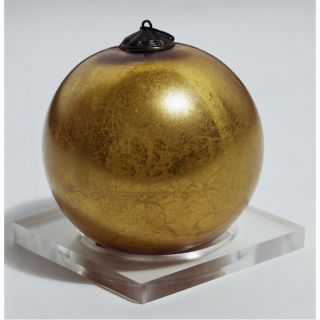
An Antique Silvered Witch Ball
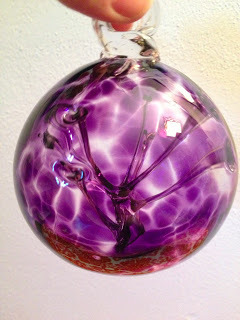
A Pairpoint Witch Ball from Salem Massachusetts
Where You Can Get One
I’ve seen them in shops in Salem MA, Boston MA, and Williamsburg VA. But if none of those places are one of your stops this summer, you can order one from either:
www.pairpoint.com
www.kitras.com
I don’t mean to be biased, but having seen witch balls made from both glass companies, I find the ones sold by Pairpoint to be more appealing. Not to mention that the company has been making them since the eighteen-hundreds! However, Kitras witch balls tend to come in a larger variety of colors and sizes. Check out both sights to see what appeals to you!
Contact Me
As always…If you have a comment or something to share, don’t be shy. Leave a comment here at the blog or contact me at aislinnmarshallwriter@gmail.comor visit my website at www.aislinnmarshall.com
Published on May 29, 2013 17:35
May 24, 2013
The Evil Eye
What it Is
The evil eye is the idea that bad luck or harm can be cast on another simply through a look. The belief is an ancient one that dates back thousands of years and remnants of it can still be found the world over. However, it is most predominant among the cultures of the Middle East and the Mediterranean.
Casters and Recipients
In some cultures the evil eye is believed to be purposefully cast by those born with the magical ability to do so. But in most, it is seen as an unintentional result of envy. But however unintentional it may be, it is still feared as a destructive force. When the evil eye is cast no one is immune, including livestock. Sadly, children are often the most affected by the evil eye and it is thought that even the compliment of a stranger about ones child can cause them to fall ill or even die if the compliment is made from a place of envy. However, illness and death represent the extreme case, and bad luck is more often attributed to the envious eye. Protection
With a curse so easily cast, (by seemingly innocent people no less) it became necessary to take protective measures in order to safeguard ones family and cattle from the evil that could befall one at any moment. In Bram Stoker’s “Dracula” he describes the towns folk performing the sign of the cross before pointing two fingers in the direction of one they thought in danger of the evil eye. He described this as, “[…] a charm or guard against the evil eye.” This protection charm is still used in parts of Europe today. It is a combination charm consisting of the Christian sign of the cross and the pagan sign of the horns. Along with this physical charm, a plethora of protective amulets and good luck charms have popped up to aid the innocent victim from the malevolent stare. Most of these items take the shape of an eye and it is believed that when the evil eye falls upon it, it will be reflected back to the gazer. The most common of these talismans is the nazar. It can be found all over the Middle East and the Mediterranean and has become a favorite souvenir of tourists traveling to the area. To look at it you might not know that you’re looking at a representation of the eye. It looks like a dark blue dot with thick rings of varying dark and light blue separated by white circling around it. This symbol has been made into many different items including sun catchers, bracelets, and beads; all beautifully crafted and ready to ward off the evil eye!

A nazar bracelet I picked up on one of my trips to Greece
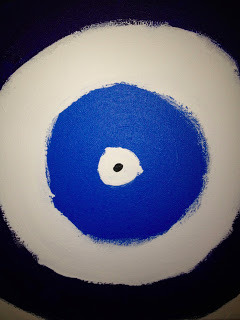
An artistic representation of the nazar
Comments
As always, I’d love to hear any comments or insight you may have on this topic. Please feel free to leave a comment here or visit my website at AislinnMarshall.com. You can also email me at AislinnMarshallWriter@gmail.com.
Published on May 24, 2013 08:45
May 20, 2013
Ghosts, Witches and Water
Lore
Ghosts can’t cross water. Witches can’t cross water. We all know this (or at least those of us consumed by the paranormal do), but did you know that the two superstitions come from two entirely different cultures? I didn’t!
Ghosts
So, in case you’re unfamiliar with the superstition, ghosts can’t cross water. In the lore, they’re even scared to come near it! In Washington Irving’s “The Legend of Sleepy Hollow” the Headless Horsemen (as well as a few lesser know specters) are known to disappear as they near the bridge that crosses the stream. And we’ve all heard the countless tales of souls trapped forever on ghost ships in the sea. It seems that this integral part of our superstition’s doctrine comes from the Gullah people of the American Deep South. Decedents of African slaves, the Gullah, have added greatly to the culture, and as it seems, superstitions here in America. They believed that there were malevolent sprits called “Haints” that were set on doing the living harm. They would scour the land looking for innocent victims of their evil doings and no one was safe from their torment. However, and most fortunately, it was believed that these vindictive spirits couldn’t cross water. But it’s not like everyone could dig a moat around his or her house. So in order to stay safe they took to painting the entrance to the house blue in hopes of tricking the spirits into thinking they were crossing water. Doors, shutters, porches, and just about any opening into the house would get the blue treatment. It became so common that the tradition lives on today in the Deep South. There, if you look closely, you can still see the ceilings of porches painted blue. I’ve even heard tell that if you go to your local Sherwin Williams, you can find a color of paint named, “Haint Blue.” Now here’s where we hit a bit of a snag. Why they believed these spirits couldn’t cross water isn’t very clear. All we know about Haints is that they were afraid of it enough that a celling painted blue would keep them at bay. But if we look at the lore of witches and water, we might find our answer.
Witches
The idea that witches can’t cross water originated during the witch hysterias in Europe. But only because this was the first time that witches were seen as something bad or evil. Prior to the witch-hunts, what we view as a witch didn’t really exist. The same women accused of cavorting with the devil were at one time seen as valuable members of the community. They were intelligent, science minded women that knew about herbs and medicines. But, for reasons I won’t delve into here, they were eventually labeled as being evil and worshipers of the devil. As for water, it has been seen as something pure and purifying since the most ancient of times. Some peoples believed that rivers were gods or created by gods. Others believed that heaven lie just beyond the ocean’s horizon. Water has always been at the center of sacred lore.So put the two beliefs together, (witches are bad and water is good) and you get the oil and water effect! One repels the other. Water is holy and pure and can’t accept evil to dwell in it. It’s the same reason why they used to throw suspected witches into water. If she sinks she innocent, the water had no need to repel her she was a good person of God. But if she floats…cry witch!
So…
Well, none of this really explains why a ghost couldn’t just float through a wall or why a witch couldn’t just find a bridge or use her broomstick, but that’s the superstition. In either culture it was clear that water was something pure, and evil whether it be a witch or a ghost, didn’t stand a chance against it!
Contact me
If you have any further insight on this topic or any I post here on the blog, I’d love to hear about it. You can leave a comment on this page, contact me through my website—AislinnMarshall.com—or email me at aislinnmarshallwriter.com.
Published on May 20, 2013 16:33
April 30, 2013
Beltane - May Day
Happy May Day
Well the sun has just about set on another April and with its setting, it ushers in another May Day! Though not as big as Christmas or the Fourth of July here in the US, it is a day that most of us have heard of and if nothing else images of maypole ribbon ceremonies and may-queens dance across our recollection if only for the briefest of moments.
For me, and I hope I’m not alone, the term May Day was something I’d always heard but thought that it was simply a colloquial term lovingly giving to the first day of May and nothing more. And any images I glimpsed of festivities were simply a celebration of the upcoming summer season, and in some small way I was right. But as my studies and research delved more into the realm of our ancient predecessors I found that it had a much deeper meaning. In fact, it referenced one of the most sacred and powerful times of the ancient year—Beltane.
Beltane
The ancient peoples of Ireland, Scotland, and The Isle of Man once celebrated a calendar of only two seasons, winter and summer. While the more well known holiday of Halloween - or Samhain as it was called in pagan times – was the beginning of the long dark winter, Beltane was the start of summer! It was a time of lighthearted celebration and ritual. The long dark half of the year was over. The stores set aside from the previous years harvest had held out and the planting season was about to begin. The cattle had all survived too and soon there would be fresh milk and meat. The warm waxing sun shown down on the earth and everything was being made new again. But the ancient peoples who’d survived yet another winter had no choice but to recognize that practically before it began, the warm sun would once again turn cold and life would ultimately depend on the harvest of the upcoming planting season. This was no time to mess around. Everything had to be done right, and that included a joyous, yet serious, ceremony of fire and light. Bel was the god of the sun and he had to be appeased by those he looked down upon and so large bonfires would be lit in his honor. But these fires served more than one purpose.
A Bridge Between Time
Beltane was literally a night outside of time. A night that acted like a bridge between the seasons of winter and summer, much like Halloween. And also like Halloween, Beltane was a time where the barrier between our world and the next was very thin. While many of the spirits believed to dwell among the living on that day and night were seen as benevolent ancestors come back to look over their living relatives, many were thought to be malevolent, or even demons of a sort. Thus the bonfires were lit to ward off the evil spirit looking to do harm. Smoke from the fires also played a large role in the night’s festivities. Cattle that had been kept locked away in earthen stalls were let out to graze on Beltane, but not before being passed through the smoke of the fires to be purified and cleansed by its protective properties and insure that the cattle would be fertile in the coming breeding season. Also, as this was seen as a time of rejuvenation and new beginnings, it became a sensible time for marriage, or handfasting as it was called. Couples would join together between the fires and participate in a marriage ceremony not much different than the ones we celebrate today. Only instead of exchanging rings, the couple’s hands would be gently tied together with twine to symbolize their union.
Celebration and Trepidation
Unlike its counterpart of Halloween, Beltane was mostly a time of happy celebration, focused on the bountiful season ahead rather than spent in trepidation over the uncertainty of the barren approaching winter. But life and death were very real for the ancient peoples of the Celtic world, and they knew that all it took was too much sun or too little rain to mean the end for not only themselves but for their community as a whole. Meaning that Beltane night had to be observed vigorously and ritualistically or the whole community wouldn’t make it through the next winter.
May Day Celebrated
In modern times Beltane has been making a comeback. Many groups such as Neo-Pagans and Wiccans celebrate the first of May much as our ancestors did. And across the country small festivals have begun popping up here and there, featuring the ever popular maypole dance, food and music. In my home, we focus on the most basic element of May Day…Summer! It’s the kick off to long warm days, BBQ’s with family and friends, road trips and days at the pool. Although I do have my own little traditions; the morning is spent getting the flowerbeds ready to be planted again after winter and then in the afternoon I head to the nursery to pick out flowers and herbs. In the evening I pull out the fire pit and the whole family gathers around to roast hot dogs and marshmallows late into the evening!
Beltane/May Day Activities
Make a May Bush – Find an old bare branch left over from the winter and decorate it with ribbons to represent flowers in honor of the planting season.
Plant Something – The upcoming planting season was one of the main focuses of Beltane. So get outside and plant something! It doesn’t have to be much, just a small potted flower or a singular herb plant.
Share a meal – Have family and friends over for a BBQ or dinner on the patio. Just get outside and enjoy the warmer weather!
Bonfire – Have a bonfire just like the Celts did! It doesn’t have to be huge, it can just be in a fire pit. Invite friends over to roast hot dogs and marshmallows. As a little something extra, gather old twigs for each guest to throw in the fire as a ceremonious show of winter dying out and summer coming in.All you guys out there – Beltane was considered the perfect time for making promises of marriage. So if you’ve been thinking of popping the question…
Volunteer or Donate – Beltane was the planting season, and our ancient ancestors knew that if they didn’t have a good planting season they wouldn’t have a good harvest. And that meant they wouldn’t make it through the winter. We have it pretty good these days. If our local harvest fails we can get fresh food from a multitude of other places. But some people still go hungry. Find a soup kitchen or shelter and volunteer. Or fill a box with some can goods and take it to the local food pantry.
Published on April 30, 2013 21:25
April 29, 2013
Welcome and Introduction
Welcome to my blog!
Well it’s finally here—my blog! And it’s long over due, I know. But after I published my book, “The Crossing,” I began to struggle with what I wanted to blog about. At first I thought as a writer it made sense to write about writing but what I really wanted to blog about was what inspires me as a writer, not just the mundane aspects of how to get from point “A” to point “B” when working on a project. Now I’m sure that as the blog goes along I’ll be posting some how-to segments for my fellow authors out there, as it was other authors’ blogs that really helped me get things going, but for now I’m going to stick to themes of inspiration.
So what’s it all about?
I’ve been fascinated with ancient folklore and the supernatural for as long as I can remember. Stories of long abandoned practices, ghosts and witches, and haunted places have always set my imagination aflame and my fingers to the keyboard where I’d create tales of my own. So it’s these paranormal and folkloric myths and legends that I want to share with you; the things that really get my mind racing and my imagination ablaze! In my coming blogs, look for ghost stories, ancient pagan belief and old superstitions. I hope you enjoy, and maybe even become inspired yourself, as I share my research and exciting little bits of the mysterious with you!
Published on April 29, 2013 20:48



